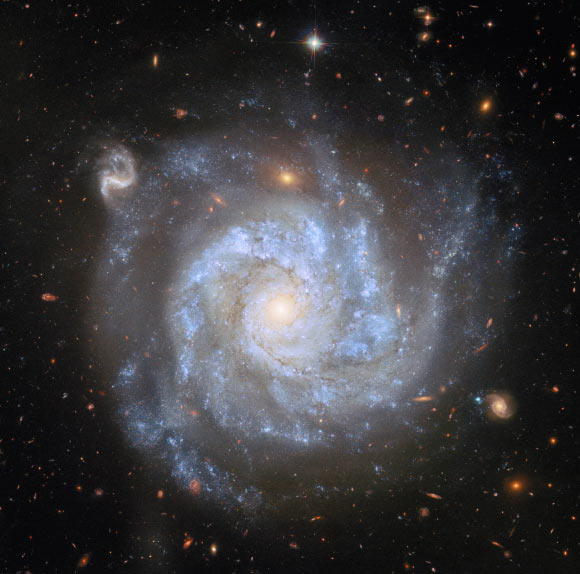The Hubble team has released a stunning new image snapped by the NASA/ESA Hubble Space Telescope of the face-on spiral galaxy NGC 1309.
This Hubble shows NGC 1309, a spiral galaxy some 100 million light-years away in the constellation of Eridanus. The color image is made up of observations from Hubble’s Advanced Camera for Surveys (ACS) and Wide Field Camera 3 (WFC3) and in the ultraviolet, infrared, and optical parts of the spectrum. Four filters were used to sample various wavelengths. The color results from assigning different hues to each monochromatic image associated with an individual filter. Image credit: NASA / ESA / Hubble / L. Galbany / S. Jha / K. Noll / A. Riess.
NGC 1309 is situated about 100 million light-years away in the constellation of Eridanus.
Otherwise known IRAS 03197-1534, LEDA 12626 or TC 470, this galaxy has a diameter of 75,000 light-years.
NGC 1309 was discovered by the German-British astronomer William Herschel on October 3, 1785.
The galaxy is the brightest member of NGC 1309 group, a trio of galaxies that also includes MCG -03-09-027 and UGCA 71.
“The stunning Hubble image encompasses NGC 1309’s bluish stars, dark brown gas clouds and pearly white center, as well as hundreds of distant background galaxies,” the Hubble astronomers said.
“Nearly every smudge, streak and blob of light in this image is an individual galaxy.”
“The only exception to the extragalactic ensemble is a star, which can be identified near the top of the frame by its diffraction spikes.”
“It is positively neighborly, just a few thousand light-years away in the Milky Way Galaxy.”
Much of NGC 1309’s scientific interest derives from two supernovae: SN 2002fk in 2002 and SN 2012Z in 2012.
“SN 2002fk was a perfect example of a Type Ia supernova, which happens when the core of a white dwarf explodes,” the astronomers said.
“SN 2012Z, on the other hand, was a bit of a renegade. It was classified as a Type Iax supernova: while its spectrum resembled that of a Type Ia supernova, the explosion wasn’t as bright as expected.”
“Hubble observations showed that in this case, the supernova did not destroy the white dwarf completely, leaving behind a ‘zombie star’ that shone even brighter than it did before the explosion.”
“Hubble observations of NGC 1309 taken across several years also made this the first time the white dwarf progenitor of a supernova has been identified in images taken before the explosion.”
